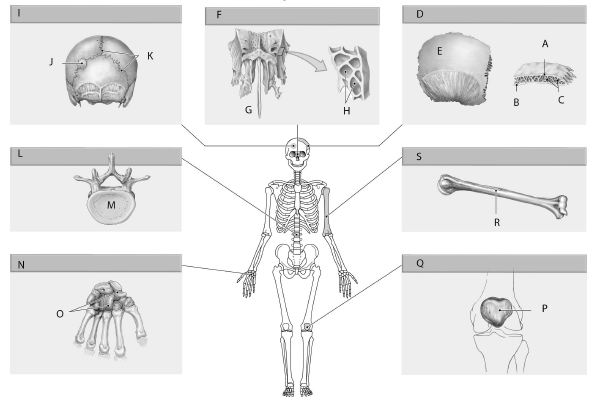Using the figure below, identify the labeled part.

1) Label A: ______________________________
2) Label B: ______________________________
3) Label C: ______________________________
4) Label D: ______________________________
5) Label E: ______________________________
6) Label F: ______________________________
7) Label G: ______________________________
8) Label H: ______________________________
9) Label I: ______________________________
10) Label J: ______________________________
11) Label K: ______________________________
12) Label L: ______________________________
13) Label M: ______________________________
14) Label N: ______________________________
15) Label O: ______________________________
16) Label P: ______________________________
17) Label Q: ______________________________
18) Label R: ______________________________
19) Label S: ______________________________
1) External table
2) Internal table
3) Diploe (spongy bone
4) Flat bone
5) Parietal bone
6) Pneumatized bone
7) Ethmoid
8) Air cells
9) Sutural bones
10) Sutural bone
11) Sutures
12) Irregular bone
13) Vertebra
14) Short bone
15) Carpal bones
16) Patella
17) Sesamoid bone
18) Humerus
19) Long bone
You might also like to view...
The correct sequence for the steps of meiosis I is
A) telophase-anaphase-metaphase-prophase B) 46 chromosomes, 23 chromosomes, then 46 chromosomes C) prophase-metaphase-anaphase-telophase D) anaphase-metaphase-prophase-telophase
Which of the following is NOT an adaptation of plants to a terrestrial environment?
A. a cuticle to prevent water loss from exposed parts of the plant B. a dominant sporophyte with vascular tissue C. the evolution of photosynthesis in order to supply the energy necessary to live on land D. stomata to regulate gas exchange with the atmosphere
If a human zygote has either 45 or 47 chromosomes it was caused by nondisjunction.
a. true b. false
Color blindness is caused by an X-linked recessive gene. A color-blind man and a woman with normal vision whose father was color blind have a son. The probability that their son is color blind is:
A) 1.00 (or 100 percent). B) 0.75 (or 75 percent). C) 0.50 (or 50 percent). D) 0.25 (or 25 percent). E) none of these.